Weex 事件传递的那些事儿
前言
在前两篇文章里面分别谈了Weex如何在Native端初始化的和Weex是如何高效的渲染Native的原生UI的。Native这边还缺一块,那就是Native产生的一些事件,是怎么传回给JS的。这篇文章就详细分析这一部分。
目录
- 1.Weex的事件类型
- 2.Weex的事件传递
一.Weex的事件类型
在Weex中,目前最新版本中事件总共分为4种类型,通用事件,Appear 事件,Disappear 事件,Page 事件。
在Weex的组件里面只包含前三种事件,即通用事件,Appear 事件,Disappear 事件。
当WXComponent添加事件的时候,会调用以下函数:
- (void)_addEventOnMainThread:(NSString *)addEventName
{
WX_ADD_EVENT(appear, addAppearEvent)
WX_ADD_EVENT(disappear, addDisappearEvent)
WX_ADD_EVENT(click, addClickEvent)
WX_ADD_EVENT(swipe, addSwipeEvent)
WX_ADD_EVENT(longpress, addLongPressEvent)
WX_ADD_EVENT(panstart, addPanStartEvent)
WX_ADD_EVENT(panmove, addPanMoveEvent)
WX_ADD_EVENT(panend, addPanEndEvent)
WX_ADD_EVENT(horizontalpan, addHorizontalPanEvent)
WX_ADD_EVENT(verticalpan, addVerticalPanEvent)
WX_ADD_EVENT(touchstart, addTouchStartEvent)
WX_ADD_EVENT(touchmove, addTouchMoveEvent)
WX_ADD_EVENT(touchend, addTouchEndEvent)
WX_ADD_EVENT(touchcancel, addTouchCancelEvent)
[self addEvent:addEventName];
}
WX_ADD_EVENT是一个宏:
#define WX_ADD_EVENT(eventName, addSelector) \
if ([addEventName isEqualToString:@#eventName]) {\
[self addSelector];\
}
即是判断待添加的事件addEventName的名字和默认支持的事件名字eventName是否一致,如果一致,就执行addSelector方法。
最后会执行一个addEvent:方法,每个组件里面会可以重写这个方法。在这个方法里面做的就是对组件的状态的标识。
比如WXWebComponent组件里面的addEvent:方法:
- (void)addEvent:(NSString *)eventName
{
if ([eventName isEqualToString:@"pagestart"]) {
_startLoadEvent = YES;
}
else if ([eventName isEqualToString:@"pagefinish"]) {
_finishLoadEvent = YES;
}
else if ([eventName isEqualToString:@"error"]) {
_failLoadEvent = YES;
}
}
在这个方法里面即对Web组件里面的状态进行了标识。
接下来就看看这几个组件是怎么识别事件的触发的。
1. 通用事件
在WXComponent的定义里,定义了如下和事件相关的变量:
@interface WXComponent ()
{
@package
BOOL _appearEvent;
BOOL _disappearEvent;
UITapGestureRecognizer *_tapGesture;
NSMutableArray *_swipeGestures;
UILongPressGestureRecognizer *_longPressGesture;
UIPanGestureRecognizer *_panGesture;
BOOL _listenPanStart;
BOOL _listenPanMove;
BOOL _listenPanEnd;
BOOL _listenHorizontalPan;
BOOL _listenVerticalPan;
WXTouchGestureRecognizer* _touchGesture;
}
上述变量里面就包含有4个手势识别器和1个自定义手势识别器。所以Weex的通用事件里面就包含这5种,点击事件,轻扫事件,长按事件,拖动事件,通用触摸事件。
(一)点击事件
首先看点击事件:
WX_ADD_EVENT(click, addClickEvent)
点击事件是通过上面这个宏加到指定视图上的。这个宏上面提到过了。这里直接把宏展开
#define WX_ADD_EVENT(click, addClickEvent) \
if ([addEventName isEqualToString:@“click”]) {\
[self addClickEvent];\
}
如果addEventName传进来event的是@“click”,那么就是执行addClickEvent方法。
- (void)addClickEvent
{
if (!_tapGesture) {
_tapGesture = [[UITapGestureRecognizer alloc] initWithTarget:self action:@selector(onClick:)];
_tapGesture.delegate = self;
[self.view addGestureRecognizer:_tapGesture];
}
}
给当前的视图增加一个点击手势,触发的方法是onClick:方法。
- (void)onClick:(__unused UITapGestureRecognizer *)recognizer
{
NSMutableDictionary *position = [[NSMutableDictionary alloc] initWithCapacity:4];
CGFloat scaleFactor = self.weexInstance.pixelScaleFactor;
if (!CGRectEqualToRect(self.calculatedFrame, CGRectZero)) {
CGRect frame = [self.view.superview convertRect:self.calculatedFrame toView:self.view.window];
position[@"x"] = @(frame.origin.x/scaleFactor);
position[@"y"] = @(frame.origin.y/scaleFactor);
position[@"width"] = @(frame.size.width/scaleFactor);
position[@"height"] = @(frame.size.height/scaleFactor);
}
[self fireEvent:@"click" params:@{@"position":position}];
}
一旦用户点击屏幕,就会触发点击手势,点击手势就会执行上述的onClick:方法。在这个方法中,Weex会计算点击出点击到的视图的坐标以及宽高尺寸。
说到这里就需要提到Weex的坐标计算方法了。
(1)计算缩放比例因子
在日常iOS开发中,开发者使用的计算单位是pt。
iPhone5分辨率320pt x 568pt
iPhone6分辨率375pt x 667pt
iPhone6 Plus分辨率414pt x 736pt
由于每个屏幕的ppi不同(ppi:Pixels Per Inch,即每英寸所拥有的像素数目,屏幕像素密度。),最终会导致分辨率的不同。
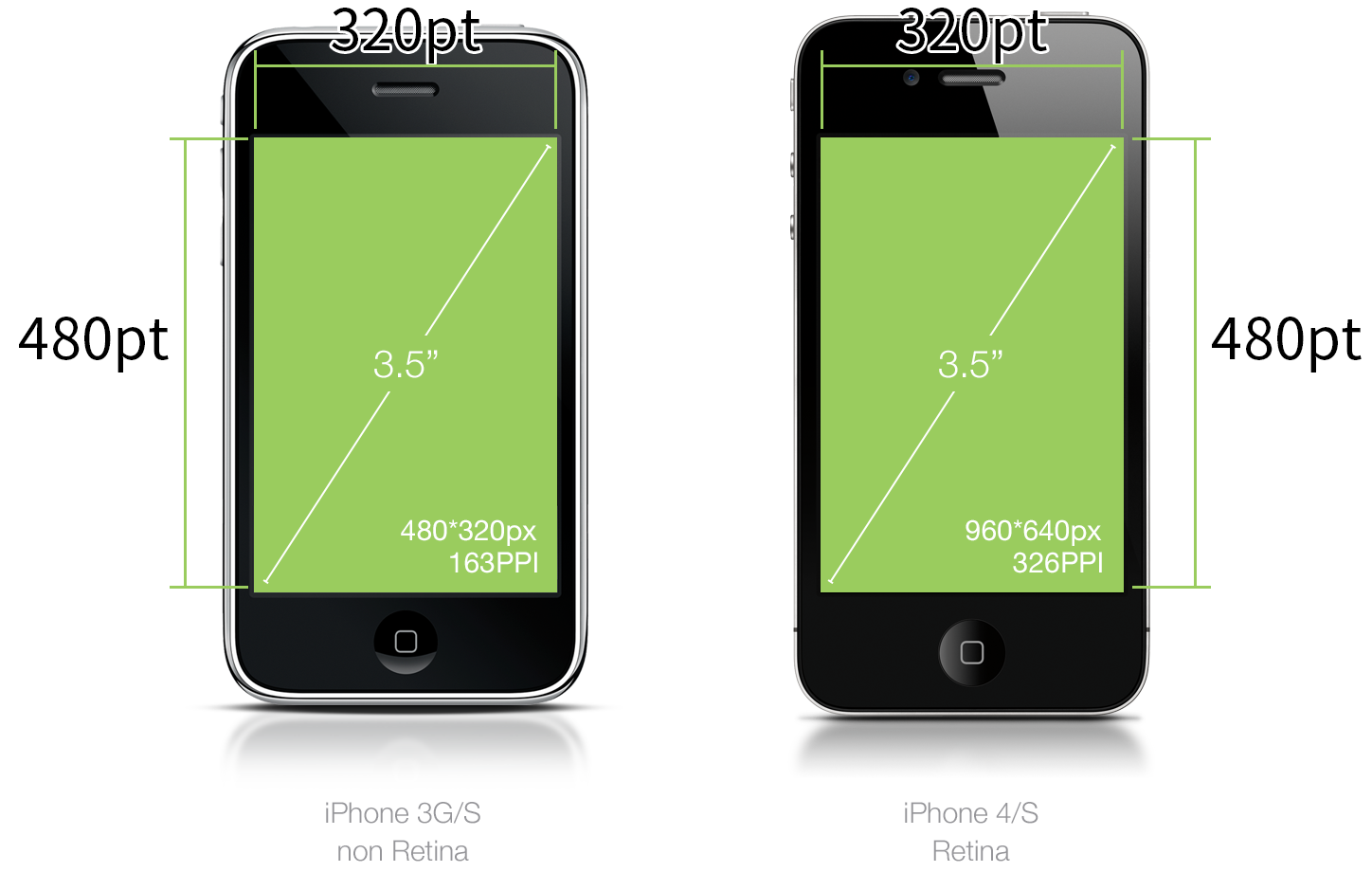
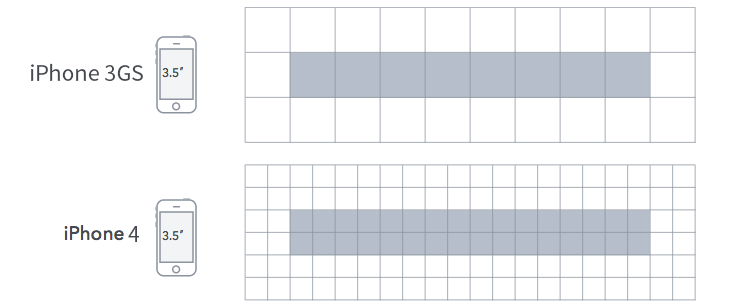
这也就是我们日常说的@1x,@2x,@3x,目前iPhone手机也就3种ppi
@1x,163ppi(iPhone3gs)
@2x,326ppi(iPhone4、4s、5、5s、6,6s,7)
@3x,401ppi(iPhone6+、6s+、7+)
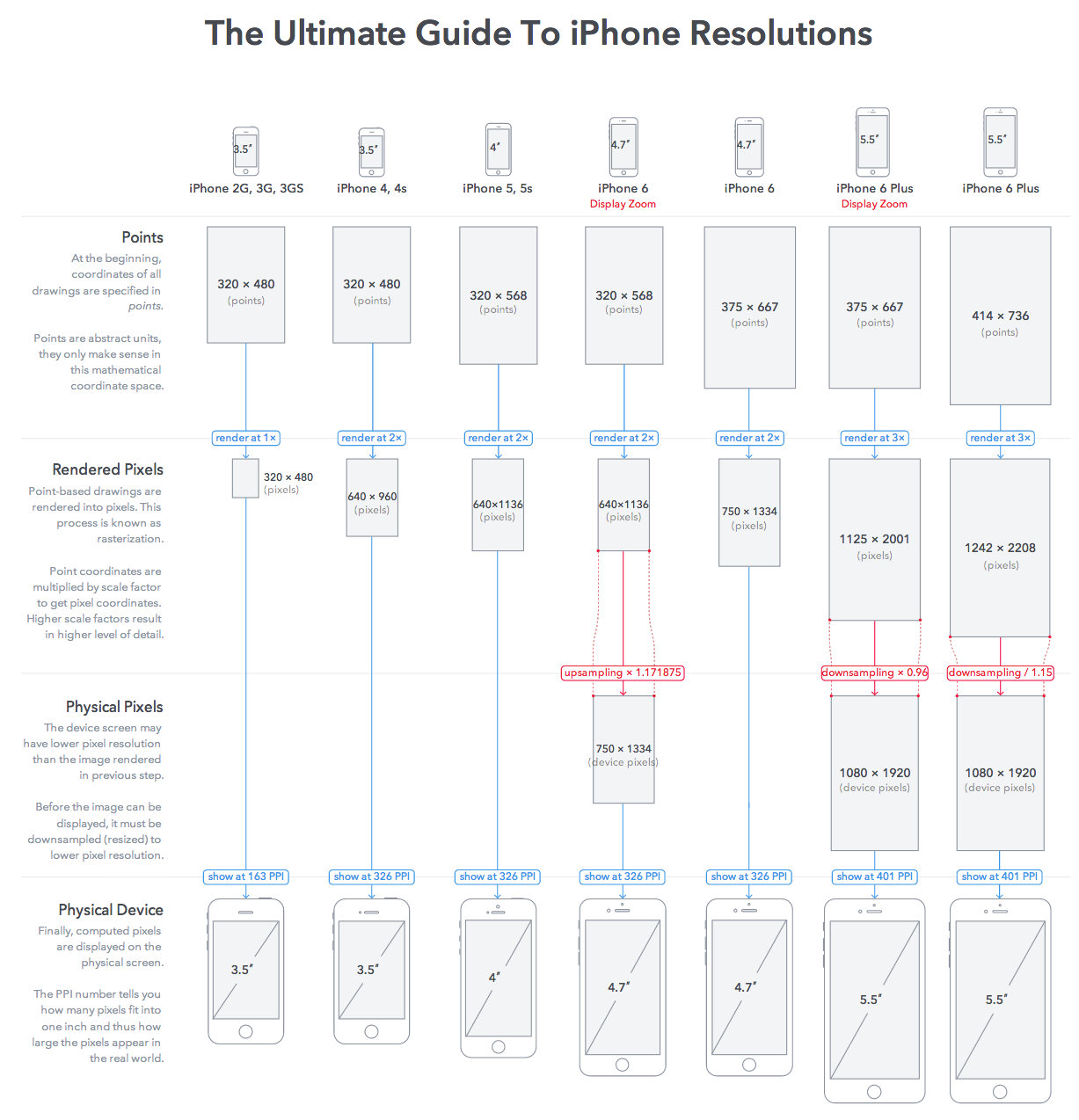
px即pixels像素,1px代表屏幕上一个物理的像素点。
iPhone5像素640px x 1136px iPhone6像素750px x 1334px iPhone6 Plus像素1242px x 2208px
而Weex的开发中,目前都是用的px,而且Weex 对于长度值目前只支持像素px值,还不支持相对单位(em、rem)。
那么就需要pt和px的换算了。
在Weex的世界里,定义了一个默认屏幕尺寸,用来适配iOS,Android各种不同大小的屏幕。
// The default screen width which helps us to calculate the real size or scale in different devices.
static const CGFloat WXDefaultScreenWidth = 750.0;
在Weex中定义的默认的屏幕宽度是750,注意是宽度。
+ (CGFloat)defaultPixelScaleFactor
{
static CGFloat defaultScaleFactor;
static dispatch_once_t onceToken;
dispatch_once(&onceToken, ^{
defaultScaleFactor = [self portraitScreenSize].width / WXDefaultScreenWidth;
});
return defaultScaleFactor;
}
这里计算了一个默认的缩放比例因子,portraitScreenSize里面计算出了屏幕在portrait方向下的大小,即如果方向是landscape,那么缩放比例因子应该等于WXScreenSize().height / WXDefaultScreenWidth,反之应该等于WXScreenSize().width / WXDefaultScreenWidth。
这里计算的是pt。
iPhone 4、4s、5、5s、5c、SE的比例因子是0.42666667 iPhone 6、6s、7比例因子是0.5 iPhone 6+、6s+、7+比例因子是0.552
(2)计算视图的缩放尺寸
计算视图的缩放尺寸主要在这个方法里面被计算。
- (void)_calculateFrameWithSuperAbsolutePosition:(CGPoint)superAbsolutePosition
gatherDirtyComponents:(NSMutableSet<WXComponent *> *)dirtyComponents
{
if (!_cssNode->layout.should_update) {
return;
}
_cssNode->layout.should_update = false;
_isLayoutDirty = NO;
// 计算视图的Frame
CGRect newFrame = CGRectMake(WXRoundPixelValue(_cssNode->layout.position[CSS_LEFT]),
WXRoundPixelValue(_cssNode->layout.position[CSS_TOP]),
WXRoundPixelValue(_cssNode->layout.dimensions[CSS_WIDTH]),
WXRoundPixelValue(_cssNode->layout.dimensions[CSS_HEIGHT]));
BOOL isFrameChanged = NO;
// 比较newFrame和_calculatedFrame,第一次_calculatedFrame为CGRectZero
if (!CGRectEqualToRect(newFrame, _calculatedFrame)) {
isFrameChanged = YES;
_calculatedFrame = newFrame;
[dirtyComponents addObject:self];
}
CGPoint newAbsolutePosition = [self computeNewAbsolutePosition:superAbsolutePosition];
_cssNode->layout.dimensions[CSS_WIDTH] = CSS_UNDEFINED;
_cssNode->layout.dimensions[CSS_HEIGHT] = CSS_UNDEFINED;
_cssNode->layout.position[CSS_LEFT] = 0;
_cssNode->layout.position[CSS_TOP] = 0;
[self _frameDidCalculated:isFrameChanged];
for (WXComponent *subcomponent in _subcomponents) {
[subcomponent _calculateFrameWithSuperAbsolutePosition:newAbsolutePosition gatherDirtyComponents:dirtyComponents];
}
}
newFrame就是计算出来的缩放过的Frame。
如果尝试自己手动计算Vue.js上设置的px与实际的视图坐标值相比,你会发现永远都差一点,虽然偏差不多,但是总有误差,原因在哪里呢?就在WXRoundPixelValue这个函数里面。
CGFloat WXRoundPixelValue(CGFloat value)
{
CGFloat scale = WXScreenScale();
return round(value * scale) / scale;
}
WXRoundPixelValue这个函数里面进行了一次四舍五入的计算,这里会对精度有所损失,所以就会导致最终Native的组件的坐标会偏差一点。
举个例子:
<style>
.pic{
width: 200px;
height: 200px;
margin-top: 100px;
left: 200px;
background-color: #a88859;
}
</style>
这里是一个imageComponent,坐标是距离上边距100px,距离左边距200px,宽200px,高200px。
假设我们是在iPhone 7+的屏幕上,ppi对应的应该是scale = 3(即@3x)。
按照Weex的上述的计算方法算,那么对应缩放的px为:
x = 200 * ( 414.0 / 750.0 ) = 110.400000
y = 100 * ( 414.0 / 750.0 ) = 55.200000
width = 200 * ( 414.0 / 750.0 ) = 110.400000
height = 200 * ( 414.0 / 750.0 ) = 110.400000
再转换成pt:
x = round ( 110.400000 * 3 ) / 3 = 110.333333
y = round ( 55.200000 * 3 ) / 3 = 55.333333
width = round ( 110.400000 * 3 ) / 3 = 110.333333
height = round ( 110.400000 * 3 ) / 3 = 110.333333
如果只是单纯的认为是针对750的成比缩放,那么这里110.333333 / ( 414.0 / 750.0 ) = 199.87922101,你会发现这个数字距离200还是差了零点几。精度就是损失在了round函数上了
那么当前的imageComponent在父视图里面的Frame = (110.333333,55.333333,110.333333,110.333333)。
回到onClick:方法里面。
- (void)onClick:(__unused UITapGestureRecognizer *)recognizer
{
NSMutableDictionary *position = [[NSMutableDictionary alloc] initWithCapacity:4];
CGFloat scaleFactor = self.weexInstance.pixelScaleFactor;
if (!CGRectEqualToRect(self.calculatedFrame, CGRectZero)) {
CGRect frame = [self.view.superview convertRect:self.calculatedFrame toView:self.view.window];
position[@"x"] = @(frame.origin.x/scaleFactor);
position[@"y"] = @(frame.origin.y/scaleFactor);
position[@"width"] = @(frame.size.width/scaleFactor);
position[@"height"] = @(frame.size.height/scaleFactor);
}
[self fireEvent:@"click" params:@{@"position":position}];
}
如果点击到视图,就会触发点击手势的处理方法,就会进入到上述方法里。
这里会计算出点击到的视图相对于window的绝对坐标。
CGRect frame = [self.view.superview convertRect:self.calculatedFrame toView:self.view.window];
上面这句话会进行一个坐标转换。坐标系转换到全局的window的左边。
还是按照上面举的例子,如果imageComponent经过转换以后,frame = (110.33333333333333, 119.33333333333334, 110.33333333333333, 110.33333333333331),这里就是y轴的距离发生了变化,因为就加上了navigation + statusBar 的64的高度。
计算出了这个window绝对坐标之后,还要还原成相对于750.0宽度的“尺寸”。这里之所以打引号,就是因为这里有精度损失,在round函数那里丢了一些精度。
x = 110.33333333333333 / ( 414.0 / 750.0 ) = 199.8792270531401
y = 119.33333333333334 / ( 414.0 / 750.0 ) = 216.1835748792271
width = 110.33333333333333 / ( 414.0 / 750.0 ) = 199.8792270531401
height = 110.33333333333333 / ( 414.0 / 750.0 ) = 199.8792270531401
上述就是点击以后经过转换最终得到的坐标,这个坐标会传递给JS。
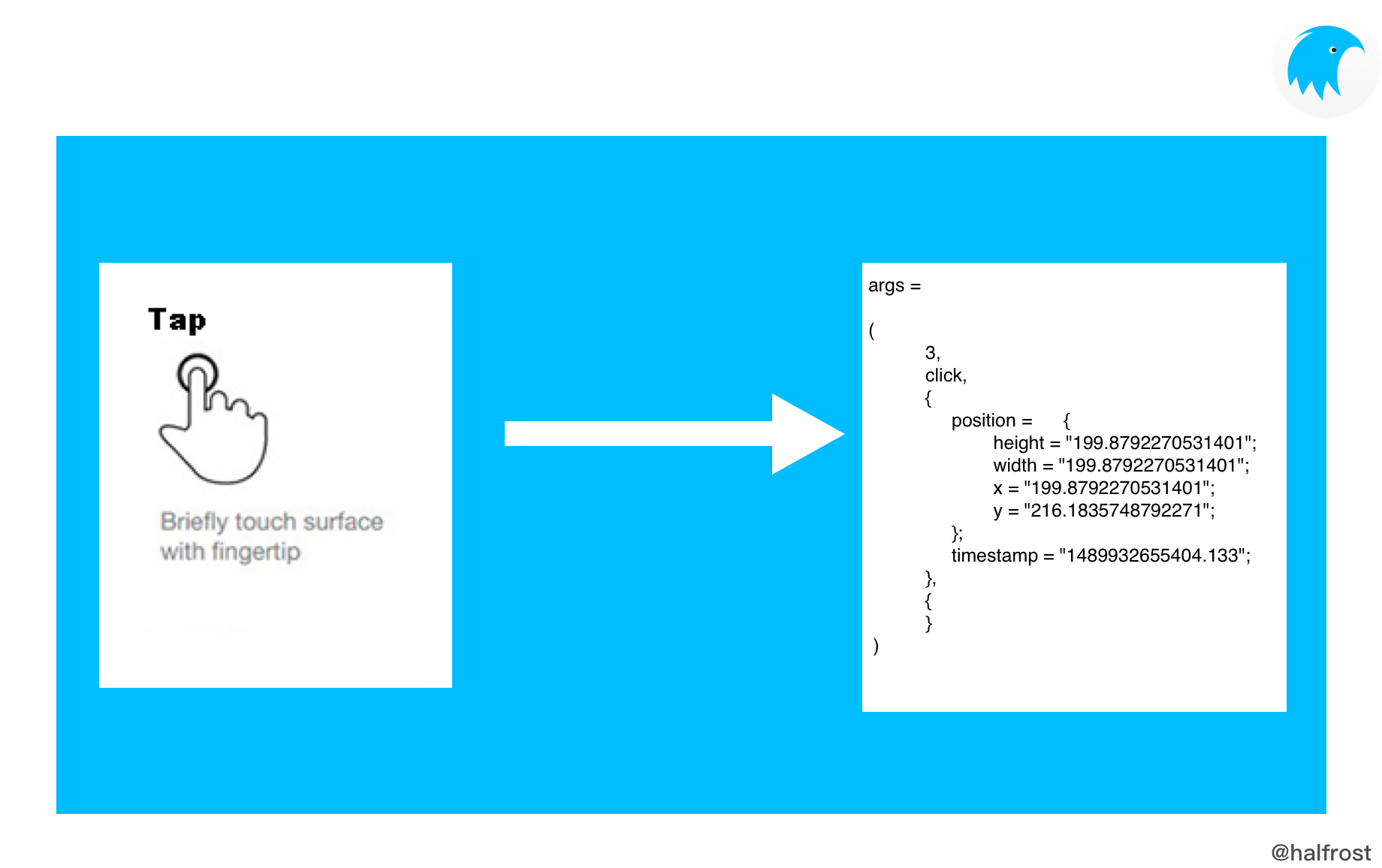
(二)轻扫事件
接着是轻扫事件。
WX_ADD_EVENT(swipe, addSwipeEvent)
这个宏和上面点击事件的展开原理一样,这里不再赘述。
如果addEventName传进来event的是@“swipe”,那么就是执行addSwipeEvent方法。
- (void)addSwipeEvent
{
if (_swipeGestures) {
return;
}
_swipeGestures = [NSMutableArray arrayWithCapacity:4];
// 下面的代码写的比较“奇怪”,原因在于UISwipeGestureRecognizer的direction属性,是一个可选的位掩码,但是每个手势识别器又只能处理一个方向的手势,所以就导致了下面需要生成四个UISwipeGestureRecognizer的手势识别器。
SEL selector = @selector(onSwipe:);
// 新建一个upSwipeRecognizer
UISwipeGestureRecognizer *upSwipeRecognizer = [[UISwipeGestureRecognizer alloc] initWithTarget:self
action:selector];
upSwipeRecognizer.direction = UISwipeGestureRecognizerDirectionUp;
upSwipeRecognizer.delegate = self;
[_swipeGestures addObject:upSwipeRecognizer];
[self.view addGestureRecognizer:upSwipeRecognizer];
// 新建一个downSwipeRecognizer
UISwipeGestureRecognizer *downSwipeRecognizer = [[UISwipeGestureRecognizer alloc] initWithTarget:self
action:selector];
downSwipeRecognizer.direction = UISwipeGestureRecognizerDirectionDown;
downSwipeRecognizer.delegate = self;
[_swipeGestures addObject:downSwipeRecognizer];
[self.view addGestureRecognizer:downSwipeRecognizer];
// 新建一个rightSwipeRecognizer
UISwipeGestureRecognizer *rightSwipeRecognizer = [[UISwipeGestureRecognizer alloc] initWithTarget:self
action:selector];
rightSwipeRecognizer.direction = UISwipeGestureRecognizerDirectionRight;
rightSwipeRecognizer.delegate = self;
[_swipeGestures addObject:rightSwipeRecognizer];
[self.view addGestureRecognizer:rightSwipeRecognizer];
// 新建一个leftSwipeRecognizer
UISwipeGestureRecognizer *leftSwipeRecognizer = [[UISwipeGestureRecognizer alloc] initWithTarget:self
action:selector];
leftSwipeRecognizer.direction = UISwipeGestureRecognizerDirectionLeft;
leftSwipeRecognizer.delegate = self;
[_swipeGestures addObject:leftSwipeRecognizer];
[self.view addGestureRecognizer:leftSwipeRecognizer];
}
上面会新建4个方向上的手势识别器。因为每个手势识别器又只能处理一个方向的手势,所以就导致了需要生成四个UISwipeGestureRecognizer的手势识别器。
给当前的视图增加一个轻扫手势,触发的方法是onSwipe:方法。
- (void)onSwipe:(UISwipeGestureRecognizer *)gesture
{
UISwipeGestureRecognizerDirection direction = gesture.direction;
NSString *directionString;
switch(direction) {
case UISwipeGestureRecognizerDirectionLeft:
directionString = @"left";
break;
case UISwipeGestureRecognizerDirectionRight:
directionString = @"right";
break;
case UISwipeGestureRecognizerDirectionUp:
directionString = @"up";
break;
case UISwipeGestureRecognizerDirectionDown:
directionString = @"down";
break;
default:
directionString = @"unknown";
}
CGPoint screenLocation = [gesture locationInView:self.view.window];
CGPoint pageLoacation = [gesture locationInView:self.weexInstance.rootView];
NSDictionary *resultTouch = [self touchResultWithScreenLocation:screenLocation pageLocation:pageLoacation identifier:gesture.wx_identifier];
[self fireEvent:@"swipe" params:@{@"direction":directionString, @"changedTouches":resultTouch ? @[resultTouch] : @[]}];
}
当用户轻扫以后,会触发轻扫手势,于是会在window上和rootView上会获取到2个坐标。
- (NSDictionary *)touchResultWithScreenLocation:(CGPoint)screenLocation pageLocation:(CGPoint)pageLocation identifier:(NSNumber *)identifier
{
NSMutableDictionary *resultTouch = [[NSMutableDictionary alloc] initWithCapacity:5];
CGFloat scaleFactor = self.weexInstance.pixelScaleFactor;
resultTouch[@"screenX"] = @(screenLocation.x/scaleFactor);
resultTouch[@"screenY"] = @(screenLocation.y/scaleFactor);
resultTouch[@"pageX"] = @(pageLocation.x/scaleFactor);
resultTouch[@"pageY"] = @(pageLocation.y/scaleFactor);
resultTouch[@"identifier"] = identifier;
return resultTouch;
}
screenLocation和pageLocation两个坐标点,还是会根据缩放比例还原成相对于750宽度的页面的坐标。screenLocation的X值和Y值、pageLocation的X值和Y值分别封装到resultTouch字典里。
@implementation UIGestureRecognizer (WXGesture)
- (NSNumber *)wx_identifier
{
NSNumber *identifier = objc_getAssociatedObject(self, _cmd);
if (!identifier) {
static NSUInteger _gestureIdentifier;
identifier = @(_gestureIdentifier++);
self.wx_identifier = identifier;
}
return identifier;
}
- (void)setWx_identifier:(NSNumber *)wx_identifier
{
objc_setAssociatedObject(self, @selector(wx_identifier), wx_identifier, OBJC_ASSOCIATION_RETAIN_NONATOMIC);
}
@end
最后resultTouch里面还包含一个identifier的参数,这个identifier是一个全局唯一的NSUInteger。wx_identifier被关联到了各个手势识别器上了。
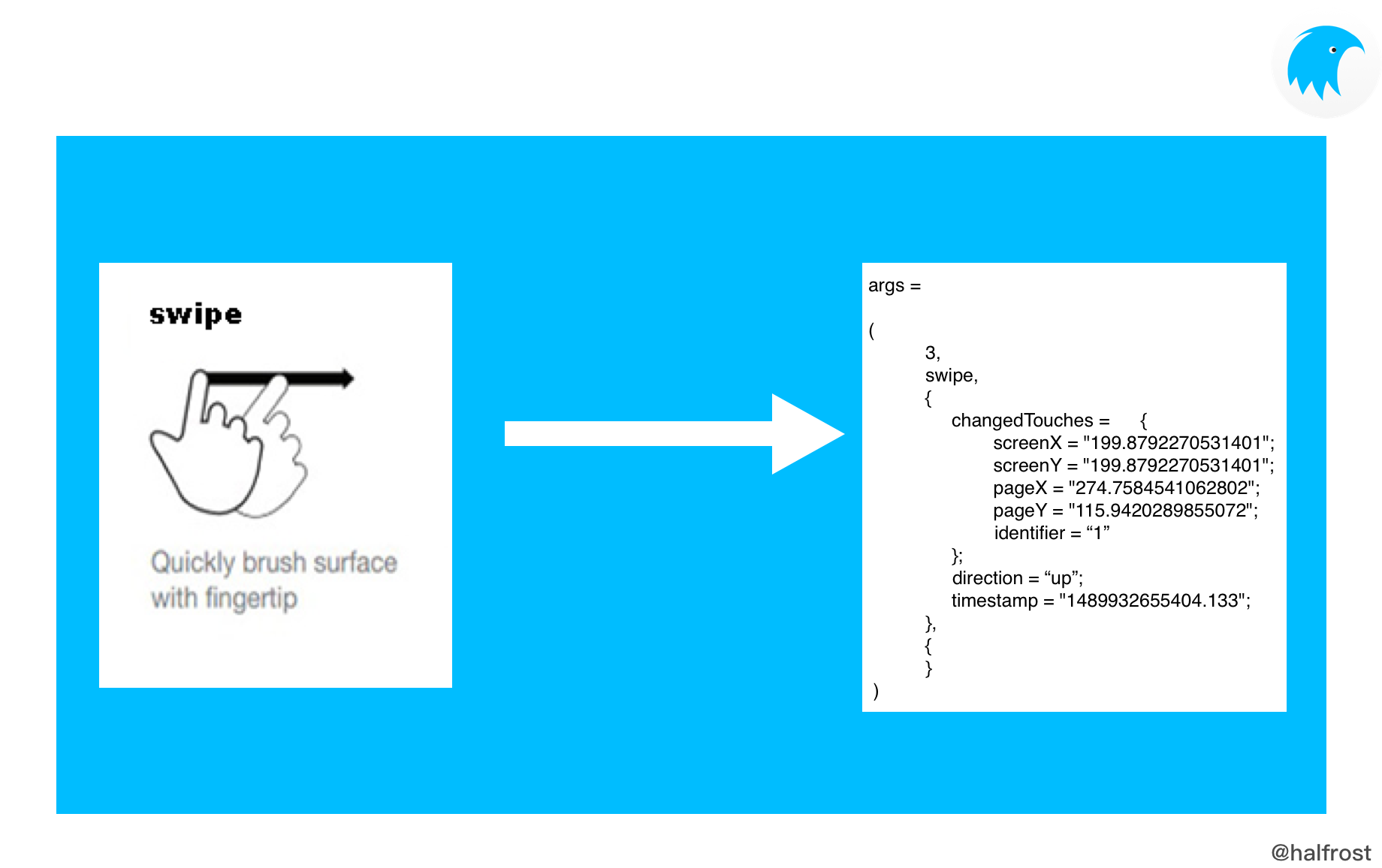
(三)长按事件
接着是轻扫事件。
WX_ADD_EVENT(longpress, addLongPressEvent)
这个宏和上面点击事件的展开原理一样,这里不再赘述。
如果addEventName传进来event的是@“longpress”,那么就是执行addLongPressEvent方法。
- (void)addLongPressEvent
{
if (!_longPressGesture) {
_longPressGesture = [[UILongPressGestureRecognizer alloc] initWithTarget:self action:@selector(onLongPress:)];
_longPressGesture.delegate = self;
[self.view addGestureRecognizer:_longPressGesture];
}
}
给当前的视图增加一个长按手势,触发的方法是onLongPress:方法。
- (void)onLongPress:(UILongPressGestureRecognizer *)gesture
{
if (gesture.state == UIGestureRecognizerStateBegan) {
CGPoint screenLocation = [gesture locationInView:self.view.window];
CGPoint pageLoacation = [gesture locationInView:self.weexInstance.rootView];
NSDictionary *resultTouch = [self touchResultWithScreenLocation:screenLocation pageLocation:pageLoacation identifier:gesture.wx_identifier];
[self fireEvent:@"longpress" params:@{@"changedTouches":resultTouch ? @[resultTouch] : @[]}];
} else if (gesture.state == UIGestureRecognizerStateEnded) {
gesture.wx_identifier = nil;
}
}
长按手势传给JS的参数和轻扫的参数changedTouches几乎一致。在长按手势开始的时候就传递给JS两个Point,screenLocation和pageLoacation,以及手势的wx_identifier。这部分和轻扫手势基本一样,不多赘述。
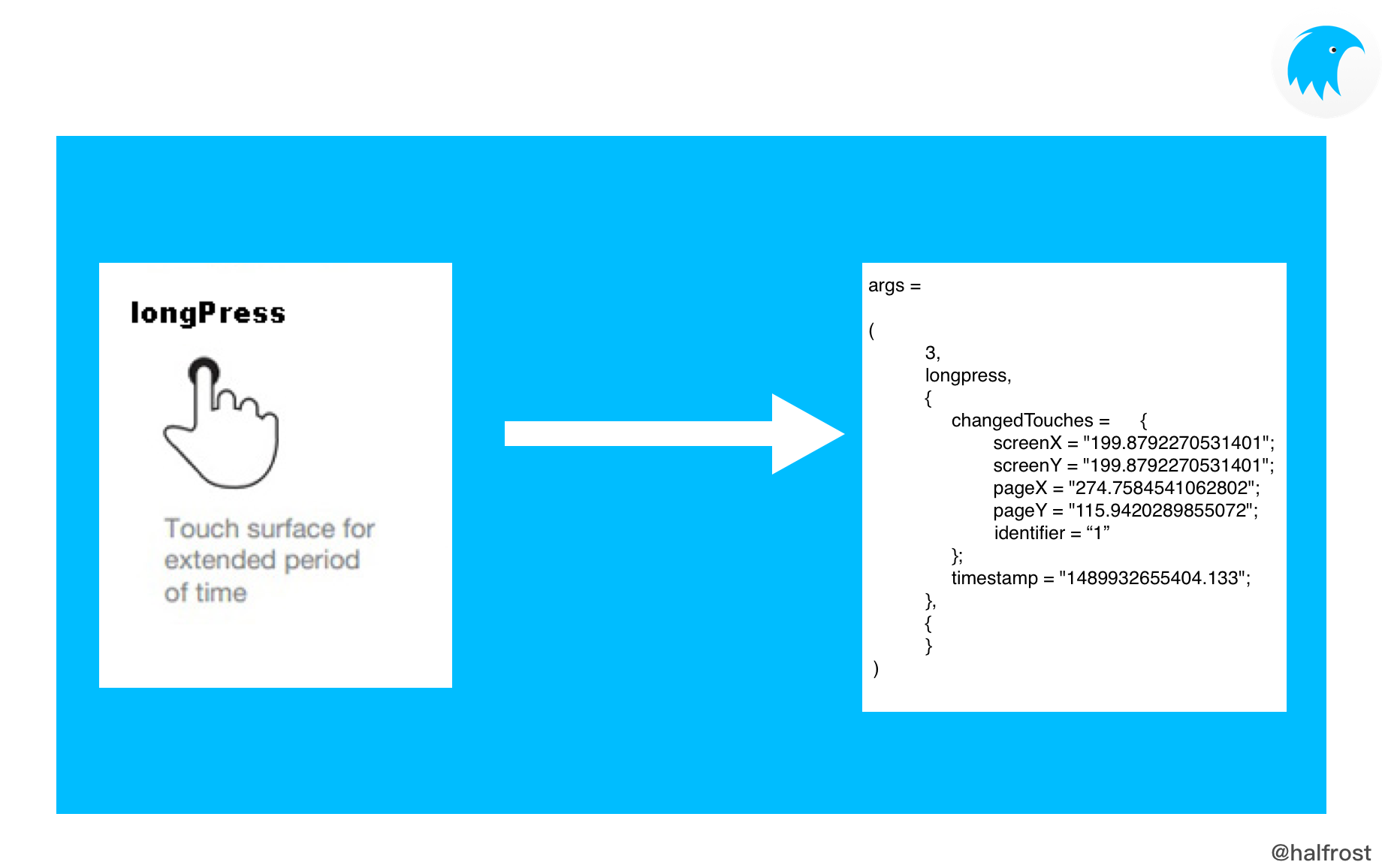
(四)拖动事件
拖动事件在Weex里面包含5个事件。分别对应着拖动的5种状态:拖动开始,拖动中,拖动结束,水平拖动,竖直拖动。
WX_ADD_EVENT(panstart, addPanStartEvent)
WX_ADD_EVENT(panmove, addPanMoveEvent)
WX_ADD_EVENT(panend, addPanEndEvent)
WX_ADD_EVENT(horizontalpan, addHorizontalPanEvent)
WX_ADD_EVENT(verticalpan, addVerticalPanEvent)
为了区分上面5种状态,Weex还对每个状态增加了一个BOOL变量来判断当前的状态。分别如下:
BOOL _listenPanStart;
BOOL _listenPanMove;
BOOL _listenPanEnd;
BOOL _listenHorizontalPan;
BOOL _listenVerticalPan;
通过宏增加的5个事件,实质都是执行了addPanGesture方法,只不过每个状态的事件都会跟对应的BOOL变量。
- (void)addPanStartEvent
{
// 拖动开始
_listenPanStart = YES;
[self addPanGesture];
}
- (void)addPanMoveEvent
{
// 拖动中
_listenPanMove = YES;
[self addPanGesture];
}
- (void)addPanEndEvent
{
// 拖动结束
_listenPanEnd = YES;
[self addPanGesture];
}
- (void)addHorizontalPanEvent
{
// 水平拖动
_listenHorizontalPan = YES;
[self addPanGesture];
}
- (void)addVerticalPanEvent
{
// 竖直拖动
_listenVerticalPan = YES;
[self addPanGesture];
}
最终都是调用addPanGesture方法:
- (void)addPanGesture
{
if (!_panGesture) {
_panGesture = [[UIPanGestureRecognizer alloc] initWithTarget:self action:@selector(onPan:)];
_panGesture.delegate = self;
[self.view addGestureRecognizer:_panGesture];
}
}
给当前的视图增加一个拖动手势,触发的方法是onPan:方法。
- (void)onPan:(UIPanGestureRecognizer *)gesture
{
CGPoint screenLocation = [gesture locationInView:self.view.window];
CGPoint pageLoacation = [gesture locationInView:self.weexInstance.rootView];
NSString *eventName;
NSString *state = @"";
NSDictionary *resultTouch = [self touchResultWithScreenLocation:screenLocation pageLocation:pageLoacation identifier:gesture.wx_identifier];
if (gesture.state == UIGestureRecognizerStateBegan) {
if (_listenPanStart) {
eventName = @"panstart";
}
state = @"start";
} else if (gesture.state == UIGestureRecognizerStateEnded) {
if (_listenPanEnd) {
eventName = @"panend";
}
state = @"end";
gesture.wx_identifier = nil;
} else if (gesture.state == UIGestureRecognizerStateChanged) {
if (_listenPanMove) {
eventName = @"panmove";
}
state = @"move";
}
CGPoint translation = [_panGesture translationInView:self.view];
if (_listenHorizontalPan && fabs(translation.y) <= fabs(translation.x)) {
[self fireEvent:@"horizontalpan" params:@{@"state":state, @"changedTouches":resultTouch ? @[resultTouch] : @[]}];
}
if (_listenVerticalPan && fabs(translation.y) > fabs(translation.x)) {
[self fireEvent:@"verticalpan" params:@{@"state":state, @"changedTouches":resultTouch ? @[resultTouch] : @[]}];
}
if (eventName) {
[self fireEvent:eventName params:@{@"changedTouches":resultTouch ? @[resultTouch] : @[]}];
}
}
拖动事件最终传给JS的resultTouch字典和前两个手势的原理一样,也是需要传入两个Point,screenLocation和pageLoacation,这里不再赘述。
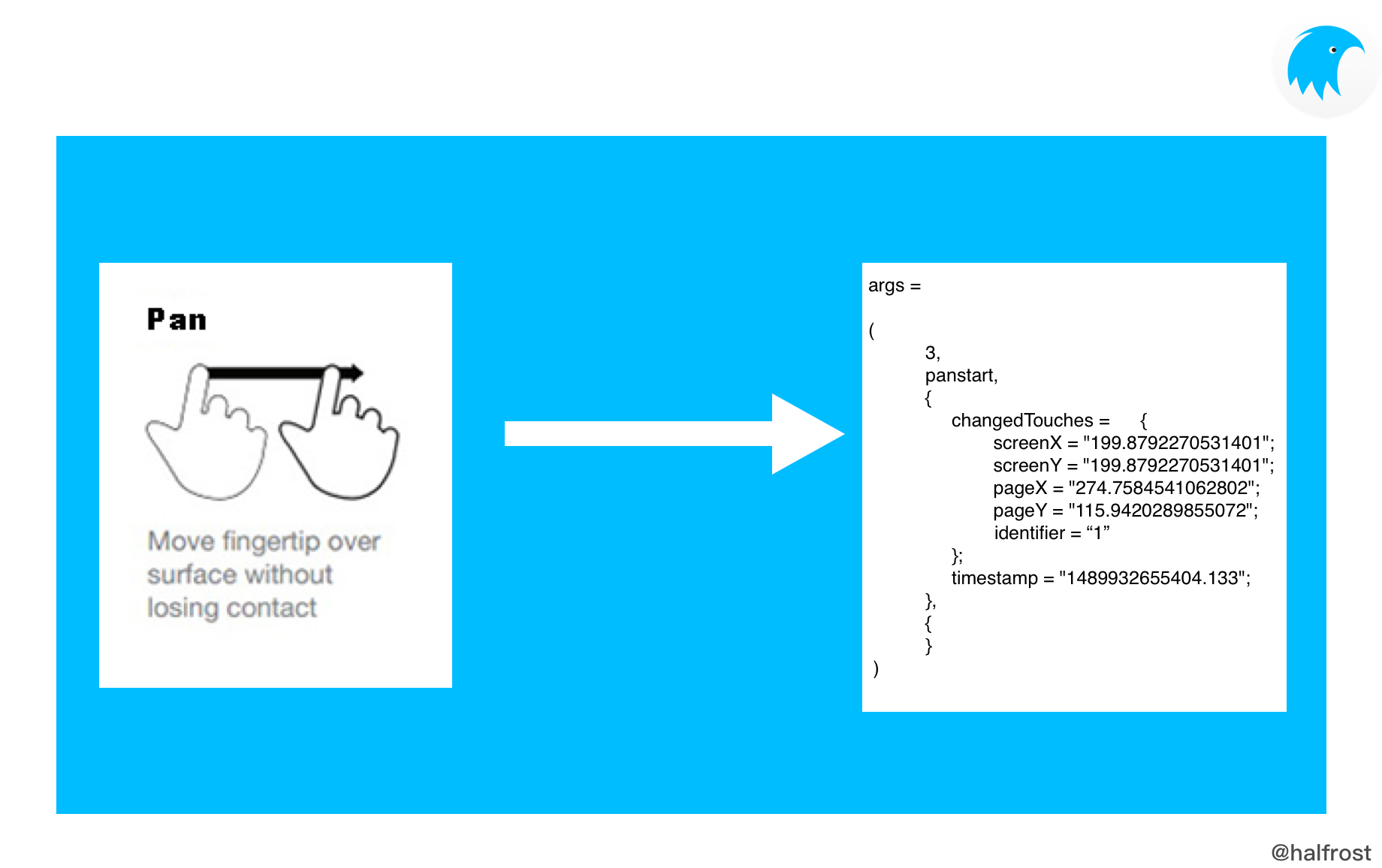
根据_listenPanStart,_listenPanEnd,_listenPanMove判断当前的状态,并生成与之对应的eventName和state字符串。
根据_panGesture在当前视图上拖动形成的有方向的向量,进行判断当前拖动的方向。
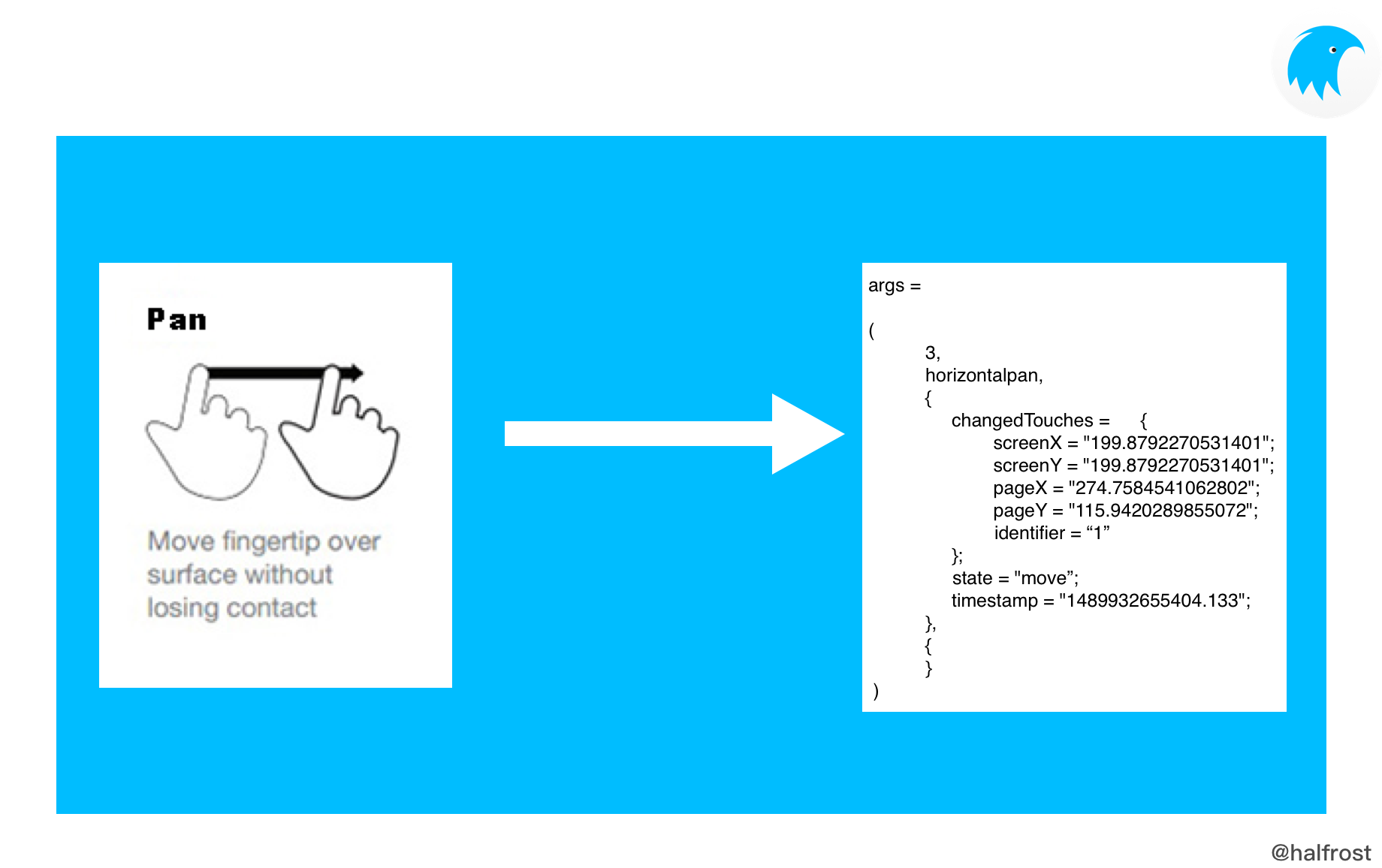
(五)通用触摸事件
最后就是通用的触摸事件。
Weex里面对每个Component都新建了一个手势识别器。
@interface WXTouchGestureRecognizer : UIGestureRecognizer
@property (nonatomic, assign) BOOL listenTouchStart;
@property (nonatomic, assign) BOOL listenTouchMove;
@property (nonatomic, assign) BOOL listenTouchEnd;
@property (nonatomic, assign) BOOL listenTouchCancel;
@property (nonatomic, assign) BOOL listenPseudoTouch;
{
__weak WXComponent *_component;
NSUInteger _touchIdentifier;
}
- (instancetype)initWithComponent:(WXComponent *)component NS_DESIGNATED_INITIALIZER;
@end
WXTouchGestureRecognizer是继承自UIGestureRecognizer。里面就5个BOOL。分别表示5种状态。
WXTouchGestureRecognizer会弱引用当前的WXComponent,并且也依旧有touchIdentifier。
Weex通过以下4个宏注册触摸事件方法。
WX_ADD_EVENT(touchstart, addTouchStartEvent)
WX_ADD_EVENT(touchmove, addTouchMoveEvent)
WX_ADD_EVENT(touchend, addTouchEndEvent)
WX_ADD_EVENT(touchcancel, addTouchCancelEvent)
通过上述宏增加的4个事件,实质都是改变每个状态的事件都会跟对应的BOOL变量。
- (void)addTouchStartEvent
{
self.touchGesture.listenTouchStart = YES;
}
- (void)addTouchMoveEvent
{
self.touchGesture.listenTouchMove = YES;
}
- (void)addTouchEndEvent
{
self.touchGesture.listenTouchEnd = YES;
}
- (void)addTouchCancelEvent
{
self.touchGesture.listenTouchCancel = YES;
}
当用户开始触摸屏幕,在屏幕上移动,手指从屏幕上结束触摸,取消触摸,分别都会触发touchesBegan:,touchesMoved:,touchesEnded:,touchesCancelled:方法。
- (void)touchesBegan:(NSSet<UITouch *> *)touches withEvent:(UIEvent *)event
{
[super touchesBegan:touches withEvent:event];
if (_listenTouchStart) {
[self fireTouchEvent:@"touchstart" withTouches:touches];
}
if(_listenPseudoTouch) {
NSMutableDictionary *styles = [_component getPseudoClassStyles:@"active"];
[_component updatePseudoClassStyles:styles];
}
}
- (void)touchesMoved:(NSSet<UITouch *> *)touches withEvent:(UIEvent *)event
{
[super touchesMoved:touches withEvent:event];
if (_listenTouchMove) {
[self fireTouchEvent:@"touchmove" withTouches:touches];
}
}
- (void)touchesEnded:(NSSet<UITouch *> *)touches withEvent:(UIEvent *)event
{
[super touchesEnded:touches withEvent:event];
if (_listenTouchEnd) {
[self fireTouchEvent:@"touchend" withTouches:touches];
}
if(_listenPseudoTouch) {
[self recoveryPseudoStyles:_component.styles];
}
}
- (void)touchesCancelled:(NSSet<UITouch *> *)touches withEvent:(UIEvent *)event
{
[super touchesCancelled:touches withEvent:event];
if (_listenTouchCancel) {
[self fireTouchEvent:@"touchcancel" withTouches:touches];
}
if(_listenPseudoTouch) {
[self recoveryPseudoStyles:_component.styles];
}
}
上述的4个事件里面实质都是在调用fireTouchEvent:withTouches:方法:
- (void)fireTouchEvent:(NSString *)eventName withTouches:(NSSet<UITouch *> *)touches
{
NSMutableArray *resultTouches = [NSMutableArray new];
for (UITouch *touch in touches) {
CGPoint screenLocation = [touch locationInView:touch.window];
CGPoint pageLocation = [touch locationInView:_component.weexInstance.rootView];
if (!touch.wx_identifier) {
touch.wx_identifier = @(_touchIdentifier++);
}
NSDictionary *resultTouch = [_component touchResultWithScreenLocation:screenLocation pageLocation:pageLocation identifier:touch.wx_identifier];
[resultTouches addObject:resultTouch];
}
[_component fireEvent:eventName params:@{@"changedTouches":resultTouches ?: @[]}];
}
最终这个方法和前3个手势一样,都需要给resultTouches传入2个Point和1个wx_identifier。原理一致。
至于坐标如何传递给JS见第二章。
2. Appear 事件
如果一个位于某个可滚动区域内的组件被绑定了 appear 事件,那么当这个组件的状态变为在屏幕上可见时,该事件将被触发。
所以绑定了Appear 事件的都是可以滚动的视图。
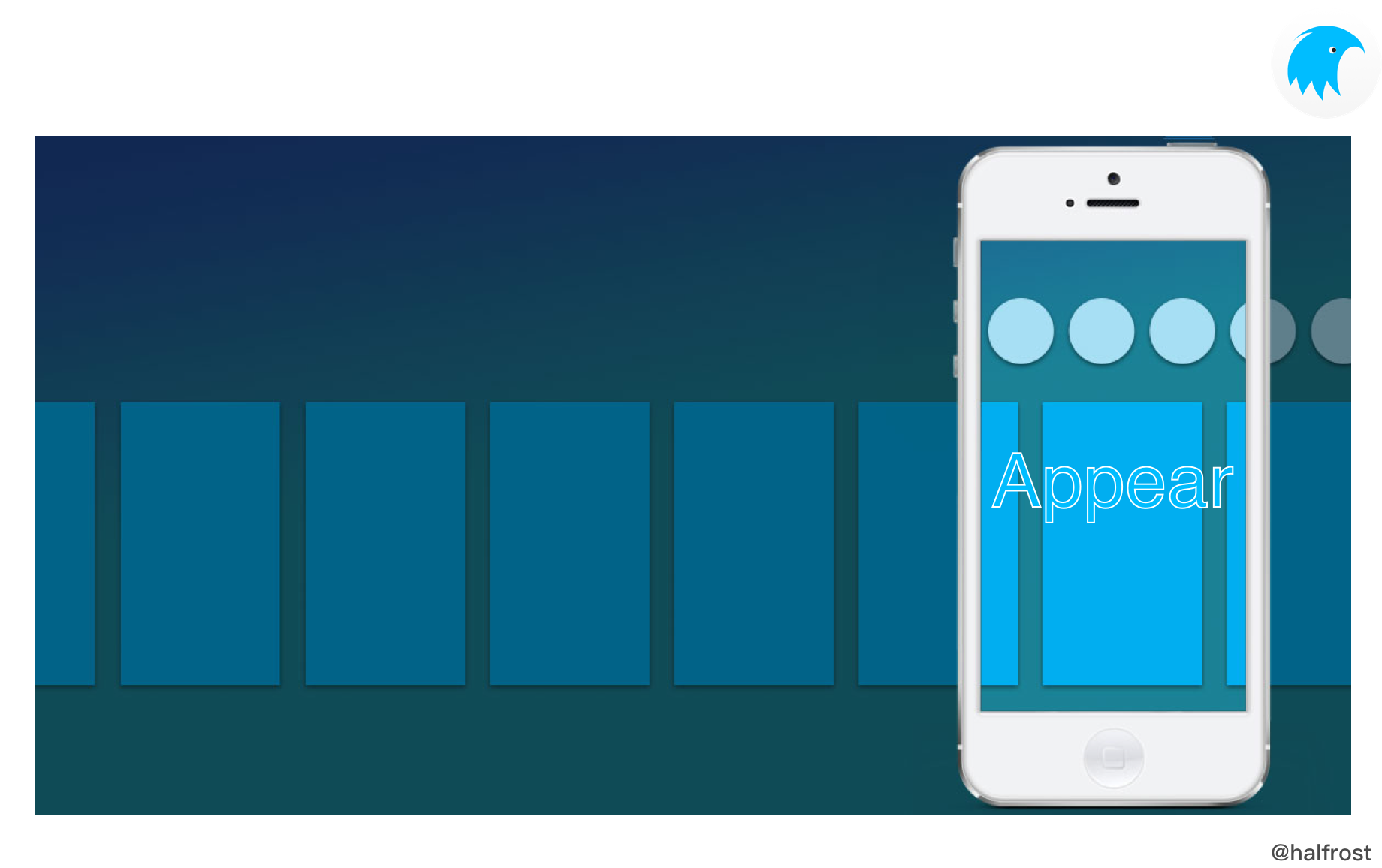
WX_ADD_EVENT(appear, addAppearEvent)
通过上述的宏给可以滚动的视图增加Appear 事件。也就是当前视图执行addAppearEvent方法。
- (void)addAppearEvent
{
_appearEvent = YES;
[self.ancestorScroller addScrollToListener:self];
}
在Weex的每个组件里面都有2个BOOL记录着当前_appearEvent和_disappearEvent的状态。
BOOL _appearEvent;
BOOL _disappearEvent;
当增加对应的事件的时候,就会把对应的BOOL变成YES。
- (id<WXScrollerProtocol>)ancestorScroller
{
if(!_ancestorScroller) {
WXComponent *supercomponent = self.supercomponent;
while (supercomponent) {
if([supercomponent conformsToProtocol:@protocol(WXScrollerProtocol)]) {
_ancestorScroller = (id<WXScrollerProtocol>)supercomponent;
break;
}
supercomponent = supercomponent.supercomponent;
}
}
return _ancestorScroller;
}
由于Appear 事件和 Disappear 事件都必须要求是滚动视图,所以这里会遍历当前视图的supercomponent,直到找到一个遵循WXScrollerProtocol的supercomponent。
- (void)addScrollToListener:(WXComponent *)target
{
BOOL has = NO;
for (WXScrollToTarget *targetData in self.listenerArray) {
if (targetData.target == target) {
has = YES;
break;
}
}
if (!has) {
WXScrollToTarget *scrollTarget = [[WXScrollToTarget alloc] init];
scrollTarget.target = target;
scrollTarget.hasAppear = NO;
[self.listenerArray addObject:scrollTarget];
}
}
在滚动视图里面包含有一个listenerArray,数组里面装的都是被监听的对象。添加进这个数组会先判断当前是否有相同的WXScrollToTarget,避免重复添加,如果没有重复的就新建一个WXScrollToTarget,再添加进listenerArray中。
@interface WXScrollToTarget : NSObject
@property (nonatomic, weak) WXComponent *target;
@property (nonatomic, assign) BOOL hasAppear;
@end
WXScrollToTarget是一个普通的对象,里面弱引用了当前需要监听的WXComponent,以及一个BOOL变量记录当前是否Appear了。
当滚动视图滚动的时候,就会触发scrollViewDidScroll:方法。
- (void)scrollViewDidScroll:(UIScrollView *)scrollView
{
//apply block which are registered
WXSDKInstance *instance = self.weexInstance;
if ([self.ref isEqualToString:WX_SDK_ROOT_REF] &&
[self isKindOfClass:[WXScrollerComponent class]]) {
if (instance.onScroll) {
instance.onScroll(scrollView.contentOffset);
}
}
if (_lastContentOffset.x > scrollView.contentOffset.x) {
_direction = @"right";
} else if (_lastContentOffset.x < scrollView.contentOffset.x) {
_direction = @"left";
} else if(_lastContentOffset.y > scrollView.contentOffset.y) {
_direction = @"down";
} else if(_lastContentOffset.y < scrollView.contentOffset.y) {
_direction = @"up";
}
_lastContentOffset = scrollView.contentOffset;
// check sticky
[self adjustSticky];
[self handleLoadMore];
[self handleAppear];
if (self.onScroll) {
self.onScroll(scrollView);
}
}
在上面的方法中[self handleAppear]就是触发了判断是否Appear了。
- (void)handleAppear
{
if (![self isViewLoaded]) {
return;
}
UIScrollView *scrollView = (UIScrollView *)self.view;
CGFloat vx = scrollView.contentInset.left + scrollView.contentOffset.x;
CGFloat vy = scrollView.contentInset.top + scrollView.contentOffset.y;
CGFloat vw = scrollView.frame.size.width - scrollView.contentInset.left - scrollView.contentInset.right;
CGFloat vh = scrollView.frame.size.height - scrollView.contentInset.top - scrollView.contentInset.bottom;
CGRect scrollRect = CGRectMake(vx, vy, vw, vh);;
// notify action for appear
for(WXScrollToTarget *target in self.listenerArray){
[self scrollToTarget:target scrollRect:scrollRect];
}
}
上面这个方法会把listenerArray数组里面的每个WXScrollToTarget对象都调用scrollToTarget:scrollRect:方法。根据当前滚动的情况传入一个CGRect,这个CGRect就是当前滚动到那个矩形区域的坐标信息以及宽和高。
- (void)scrollToTarget:(WXScrollToTarget *)target scrollRect:(CGRect)rect
{
WXComponent *component = target.target;
if (![component isViewLoaded]) {
return;
}
// 计算出当前的可见区域的顶部坐标
CGFloat ctop;
if (component && component->_view && component->_view.superview) {
ctop = [component->_view.superview convertPoint:component->_view.frame.origin toView:_view].y;
} else {
ctop = 0.0;
}
// 计算出当前的可见区域的底部坐标
CGFloat cbottom = ctop + CGRectGetHeight(component.calculatedFrame);
// 计算出当前的可见区域的左边界坐标
CGFloat cleft;
if (component && component->_view && component->_view.superview) {
cleft = [component->_view.superview convertPoint:component->_view.frame.origin toView:_view].x;
} else {
cleft = 0.0;
}
// 计算出当前的可见区域的右边界坐标
CGFloat cright = cleft + CGRectGetWidth(component.calculatedFrame);
// 获取传入的滚动的区域
CGFloat vtop = CGRectGetMinY(rect), vbottom = CGRectGetMaxY(rect), vleft = CGRectGetMinX(rect), vright = CGRectGetMaxX(rect);
// 判断当前可见区域是否包含在传入的滚动区域内,如果在,并且监听了appear事件,就触发appear事件,否则如果监听了disappear事件就触发disappear事件
if(cbottom > vtop && ctop <= vbottom && cleft <= vright && cright > vleft){
if(!target.hasAppear && component){
target.hasAppear = YES;
// 如果当前监听了appear,就触发appear事件
if (component->_appearEvent) {
[component fireEvent:@"appear" params:_direction ? @{@"direction":_direction} : nil];
}
}
} else {
if(target.hasAppear && component){
target.hasAppear = NO;
// 如果当前监听了disappear,就触发disappear事件
if(component->_disappearEvent){
[component fireEvent:@"disappear" params:_direction ? @{@"direction":_direction} : nil];
}
}
}
}
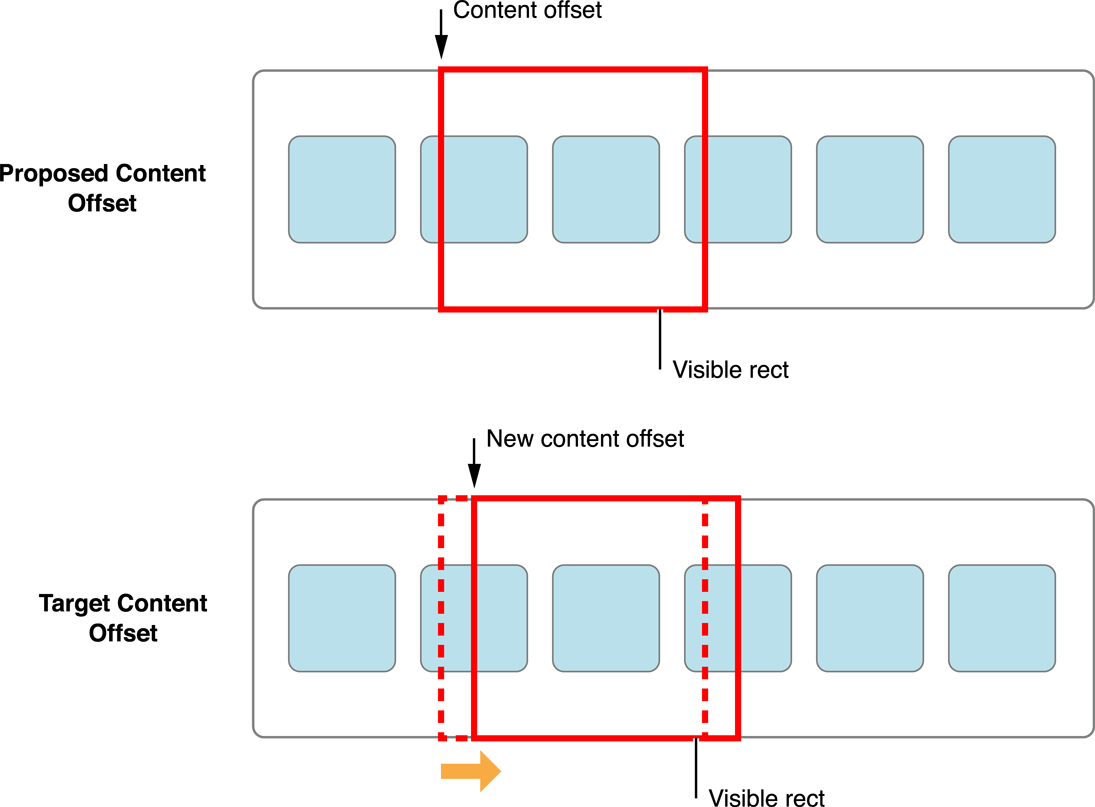
scrollToTarget:scrollRect:方法的核心就是拿当前可视区域和传入的滚动区域进行对比,如果在该区域内,且监听了appear事件,就会触发appear事件,如果不在该区域内,且监听了disappear事件,就会触发disappear事件。
3. Disappear 事件
如果一个位于某个可滚动区域内的组件被绑定了 disappear 事件,那么当这个组件被滑出屏幕变为不可见状态时,该事件将被触发。
同理,绑定了Disappear 事件的都是可以滚动的视图。
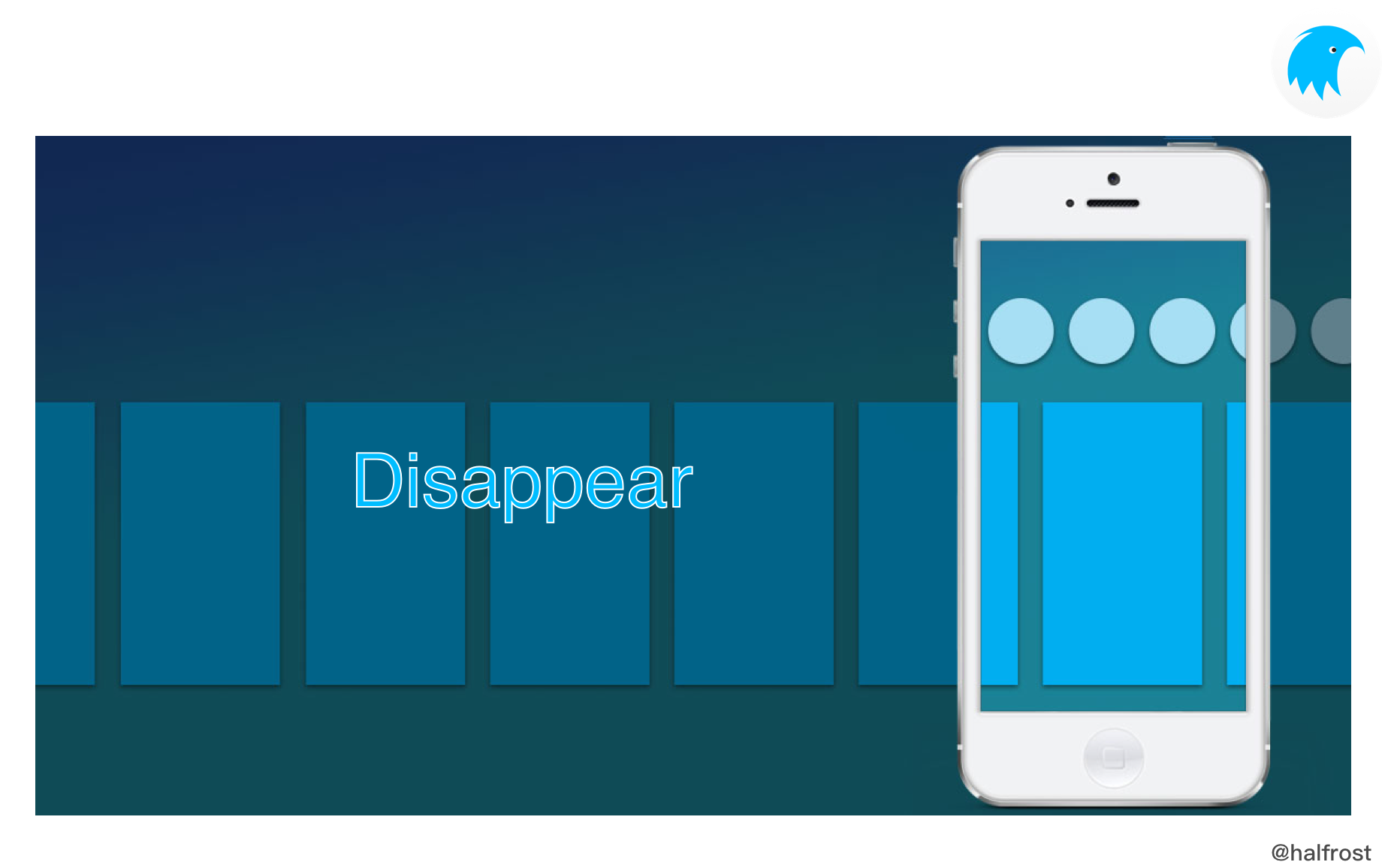
WX_ADD_EVENT(disappear, addDisappearEvent)
通过上述的宏给可以滚动的视图增加Disappear 事件。也就是当前视图执行addDisappearEvent方法。
- (void)addDisappearEvent
{
_disappearEvent = YES;
[self.ancestorScroller addScrollToListener:self];
}
接下去的和Appear 事件的原理就一模一样了。
4. Page 事件
暂时Weex只支持 iOS 和 Android,H5 暂不支持。
Weex 通过 viewappear 和 viewdisappear 事件提供了简单的页面状态管理能力。
viewappear 事件会在页面就要显示或配置的任何页面动画被执行前触发,例如,当调用 navigator 模块的 push 方法时,该事件将会在打开新页面时被触发。viewdisappear 事件会在页面就要关闭时被触发。
与组件Component的 appear 和 disappear 事件不同的是,viewappear 和 viewdisappear 事件关注的是整个页面的状态,所以它们必须绑定到页面的根元素上。
特殊情况下,这两个事件也能被绑定到非根元素的body组件上,例如wxc-navpage组件。
举个例子:
- (void)_updateInstanceState:(WXState)state
{
if (_instance && _instance.state != state) {
_instance.state = state;
if (state == WeexInstanceAppear) {
[[WXSDKManager bridgeMgr] fireEvent:_instance.instanceId ref:WX_SDK_ROOT_REF type:@"viewappear" params:nil domChanges:nil];
} else if (state == WeexInstanceDisappear) {
[[WXSDKManager bridgeMgr] fireEvent:_instance.instanceId ref:WX_SDK_ROOT_REF type:@"viewdisappear" params:nil domChanges:nil];
}
}
}
比如在WXBaseViewController里面,有这样一个更新当前Instance状态的方法,这个方法里面就会触发 viewappear 和 viewdisappear 事件。
其中WX_SDK_ROOT_REF就是_root
#define WX_SDK_ROOT_REF @"_root"
上述更新状态的方法同样出现在WXEmbedComponent组件中。
- (void)_updateState:(WXState)state
{
if (_renderFinished && _embedInstance && _embedInstance.state != state) {
_embedInstance.state = state;
if (state == WeexInstanceAppear) {
[self setNavigationWithStyles:self.embedInstance.naviBarStyles];
[[WXSDKManager bridgeMgr] fireEvent:self.embedInstance.instanceId ref:WX_SDK_ROOT_REF type:@"viewappear" params:nil domChanges:nil];
}
else if (state == WeexInstanceDisappear) {
[[WXSDKManager bridgeMgr] fireEvent:self.embedInstance.instanceId ref:WX_SDK_ROOT_REF type:@"viewdisappear" params:nil domChanges:nil];
}
}
}
二.Weex的事件传递
在Weex中,iOS Native把事件传递给JS目前只有2种方式,一是Module模块的callback,二是通过Component组件自定义的通知事件。
(1)callback
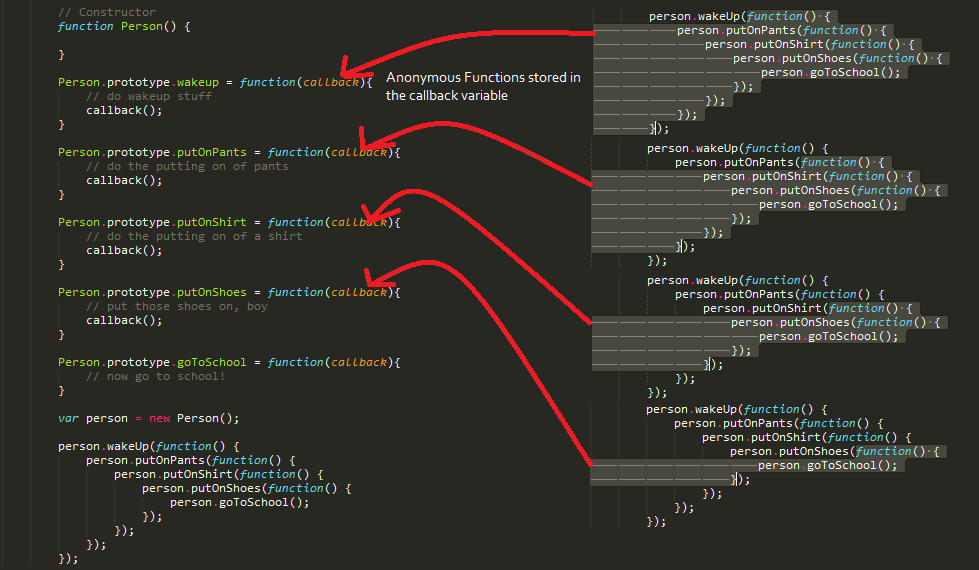
在WXModuleProtocol中定义了2种可以callback给JS的闭包。
/**
* @abstract the module callback , result can be string or dictionary.
* @discussion callback data to js, the id of callback function will be removed to save memory.
*/
typedef void (^WXModuleCallback)(id result);
/**
* @abstract the module callback , result can be string or dictionary.
* @discussion callback data to js, you can specify the keepAlive parameter to keep callback function id keepalive or not. If the keepAlive is true, it won't be removed until instance destroyed, so you can call it repetitious.
*/
typedef void (^WXModuleKeepAliveCallback)(id result, BOOL keepAlive);
两个闭包都可以callback把data传递回给JS,data可以是字符串或者字典。
这两个闭包的区别在于:
- WXModuleCallback用于Module组件,为了节约内存,该回调只能回调通知JS一次,之后会被释放,多用于一次结果。
- WXModuleKeepAliveCallback同样是用于Module组件,但是该回调可以设置是否为多次回调类型,如果设置了keepAlive,那么可以进行持续监听变化,多次回调,并返回给 JS。
在Weex中使用WXModuleCallback回调,很多情况是把状态回调给JS,比如成功或者失败的状态,还有一些出错的信息回调给JS。
比如在WXStorageModule中
- (void)setItem:(NSString *)key value:(NSString *)value callback:(WXModuleCallback)callback
{
if ([self checkInput:key]) {
callback(@{@"result":@"failed",@"data":@"key must a string or number!"});
return;
}
if ([self checkInput:value]) {
callback(@{@"result":@"failed",@"data":@"value must a string or number!"});
return;
}
if ([key isKindOfClass:[NSNumber class]]) {
key = [((NSNumber *)key) stringValue];
}
if ([value isKindOfClass:[NSNumber class]]) {
value = [((NSNumber *)value) stringValue];
}
if ([WXUtility isBlankString:key]) {
callback(@{@"result":@"failed",@"data":@"invalid_param"});
return ;
}
[self setObject:value forKey:key persistent:NO callback:callback];
}
在调用setItem:value:callback:方法里面,如果setKey-value的时候失败了,会把错误信息通过WXModuleCallback回调给JS。
当然,如果调用存储模块WXStorageModule的某些查询信息的方法:
- (void)length:(WXModuleCallback)callback
{
callback(@{@"result":@"success",@"data":@([[WXStorageModule memory] count])});
}
- (void)getAllKeys:(WXModuleCallback)callback
{
callback(@{@"result":@"success",@"data":[WXStorageModule memory].allKeys});
}
length:和getAllKeys:方法调用成功,会把成功的状态和数据通过WXModuleCallback回调给JS。
在Weex中使用了WXModuleKeepAliveCallback的模块总共只有以下4个:
WXDomModule,WXStreamModule,WXWebSocketModule,WXGlobalEventModule
在WXDomModule模块中,JS调用获取Component组件的位置信息和宽高信息的时候,需要把这些坐标和尺寸信息回调给JS,不过这里虽然用到了WXModuleKeepAliveCallback,但是keepAlive是false,并没有用到多次回调的功能。
在WXStreamModule模块中,由于这是一个传输流的模块,所以肯定需要用到WXModuleKeepAliveCallback,需要持续不断的监听数据的变化,并把进度回调给JS,这里用到了keepAlive。WXStreamModule模块中也会用到WXModuleCallback,WXModuleCallback会即时把各个状态回调给JS。
在WXWebSocketModule模块中
@interface WXWebSocketModule()
@property(nonatomic,copy)WXModuleKeepAliveCallback errorCallBack;
@property(nonatomic,copy)WXModuleKeepAliveCallback messageCallBack;
@property(nonatomic,copy)WXModuleKeepAliveCallback openCallBack;
@property(nonatomic,copy)WXModuleKeepAliveCallback closeCallBack;
@end
用到了4个WXModuleKeepAliveCallback回调,这4个callback分别是把error错误信息,message收到的数据,open打开链接的状态,close关闭链接的状态,持续的回调给JS。
在WXGlobalEventModule模块中,有一个fireGlobalEvent:方法。
- (void)fireGlobalEvent:(NSNotification *)notification
{
NSDictionary * userInfo = notification.userInfo;
NSString * userWeexInstanceId = userInfo[@"weexInstance"];
WXSDKInstance * userWeexInstance = [WXSDKManager instanceForID:userWeexInstanceId];
// 防止userInstanceId存在,但是instance实际已经被销毁了
if (!userWeexInstanceId || userWeexInstance == weexInstance) {
for (WXModuleKeepAliveCallback callback in _eventCallback[notification.name]) {
callback(userInfo[@"param"], true);
}
}
}
开发者可以通过WXGlobalEventModule进行全局的通知,在userInfo里面可以夹带weexInstance的参数。native是不需要关心userWeexInstanceId,这个参数是给JS用的。
Native开发者只需要在用到了WXGlobalEventModule的模块里加上事件的监听者,然后发送全局通知即可。userInfo[@“param”]会被回调给JS。
(2)fireEvent:params:domChanges:

在开头我们介绍的Weex事件的4种类型,通用事件,Appear 事件,Disappear 事件,Page 事件,全部都是通过fireEvent:params:domChanges:这种方式,Native触发事件之后,Native把参数传递给JS的。
在WXComponent里面定义了2个可以给JS发送消息的方法:
/**
* @abstract Fire an event to the component in Javascript.
*
* @param eventName The name of the event to fire
* @param params The parameters to fire with
**/
- (void)fireEvent:(NSString *)eventName params:(nullable NSDictionary *)params;
/**
* @abstract Fire an event to the component and tell Javascript which value has been changed.
* Used for two-way data binding.
*
* @param eventName The name of the event to fire
* @param params The parameters to fire with
* @param domChanges The values has been changed, used for two-way data binding.
**/
- (void)fireEvent:(NSString *)eventName params:(nullable NSDictionary *)params domChanges:(nullable NSDictionary *)domChanges;
这两个方法的区别就在于最后一个domChanges的参数,有这个参数的方法主要多用于Weex的Native和JS的双向数据绑定。
- (void)fireEvent:(NSString *)eventName params:(NSDictionary *)params
{
[self fireEvent:eventName params:params domChanges:nil];
}
- (void)fireEvent:(NSString *)eventName params:(NSDictionary *)params domChanges:(NSDictionary *)domChanges
{
NSMutableDictionary *dict = [NSMutableDictionary dictionary];
NSTimeInterval timeSp = [[NSDate date] timeIntervalSince1970] * 1000;
[dict setObject:@(timeSp) forKey:@"timestamp"];
if (params) {
[dict addEntriesFromDictionary:params];
}
[[WXSDKManager bridgeMgr] fireEvent:self.weexInstance.instanceId ref:self.ref type:eventName params:dict domChanges:domChanges];
}
上述就是两个方法的具体实现。可以看到fireEvent:params:方法就是调用了fireEvent:params:domChanges:方法,只不过最后的domChanges参数传了nil。
在fireEvent:params:domChanges:方法中会对params字典做了一次加工,加上了timestamp的键值。最终还是会调用WXBridgeManager 里面的fireEvent:ref: type:params:domChanges:方法。
在WXBridgeManager中具体实现了上述的两个方法。
- (void)fireEvent:(NSString *)instanceId ref:(NSString *)ref type:(NSString *)type params:(NSDictionary *)params
{
[self fireEvent:instanceId ref:ref type:type params:params domChanges:nil];
}
- (void)fireEvent:(NSString *)instanceId ref:(NSString *)ref type:(NSString *)type params:(NSDictionary *)params domChanges:(NSDictionary *)domChanges
{
if (!type || !ref) {
WXLogError(@"Event type and component ref should not be nil");
return;
}
NSArray *args = @[ref, type, params?:@{}, domChanges?:@{}];
WXSDKInstance *instance = [WXSDKManager instanceForID:instanceId];
WXCallJSMethod *method = [[WXCallJSMethod alloc] initWithModuleName:nil methodName:@"fireEvent" arguments:args instance:instance];
[self callJsMethod:method];
}
入参ref, type, params, domChanges封装到最终的args参数数组里面,最后会封装出WXCallJSMethod方法,通过WXBridgeManager的callJsMethod调用到JS的fireEvent方法。

这里可以举个例子:
假设一个场景,用户点击了一张图片,于是就会改变label上的一段文字。
首先图片是imageComponent,用户点击会触发该Component的onclick:方法
组件里面会调用fireEvent:params:方法:
[self fireEvent:@"click" params:@{@"position":position}];
最终通过fireEvent:params:domChanges:方法,发送给JS的参数字典大概如下:
args:(
0,
(
{
args = (
3,
click,
{
position = {
height = "199.8792270531401";
width = "199.8792270531401";
x = "274.7584541062802";
y = "115.9420289855072";
};
timestamp = "1489932655404.133";
},
{
}
);
method = fireEvent;
module = "";
}
)
)
JSFramework收到了fireEvent方法调用以后,处理完,知道label需要更新,于是又会开始call Native,调用Native的方法。调用Native的callNative方法,发过来的参数如下:
(
{
args = (
4,
{
value = "\U56fe\U7247\U88ab\U70b9\U51fb";
}
);
method = updateAttrs;
module = dom;
}
)
最终会调用Dom的updateAttrs方法,会去更新id为4的value,id为4对应的就是label,更新它的值就是刷新label。
接着JSFramework还会继续调用Native的callNative方法,发过来的参数如下:
(
{
args = (
);
method = updateFinish;
module = dom;
}
)
调用Dom的updateFinish方法,即页面刷新完毕。
最后
至此,Weex从View的创建,到渲染,产生事件回调JSFramework,这一系列的流程源码都解析完成了。
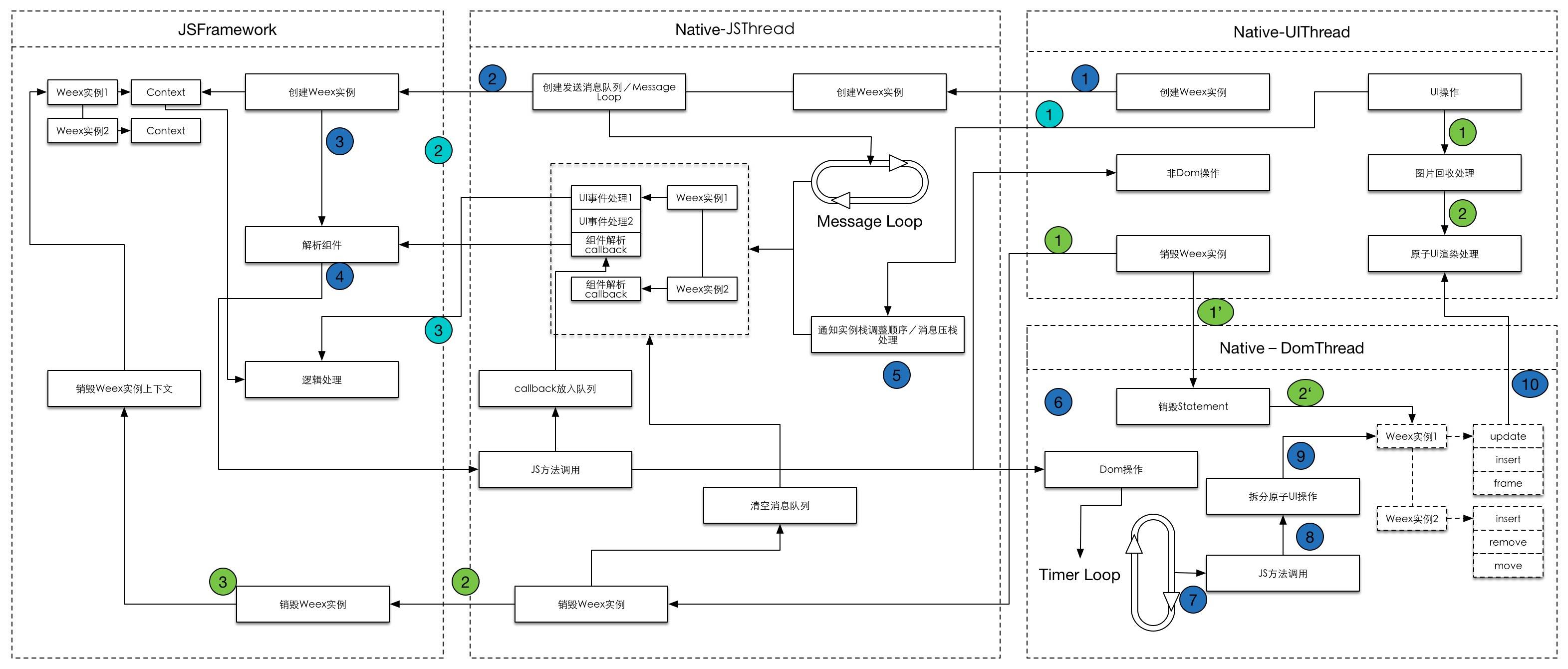
中间涉及到了3个子线程,mainThread,com.taobao.weex.component,com.taobao.weex.bridge,分别是UI主线程,DOM线程,JSbridge线程。
Native端目前还差神秘的JSFramework的源码解析。请大家多多指点。
